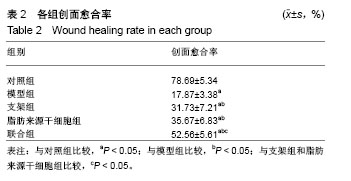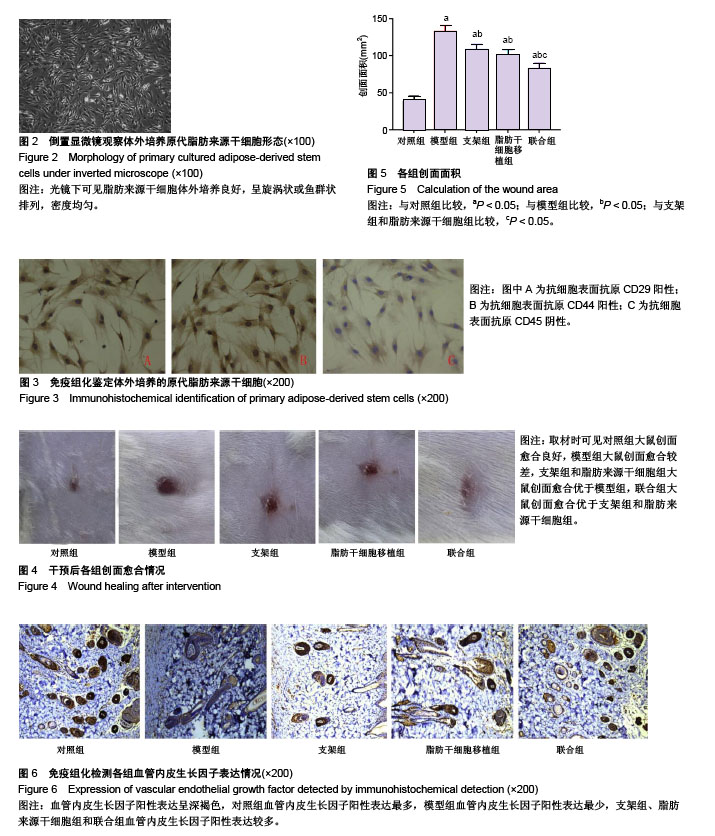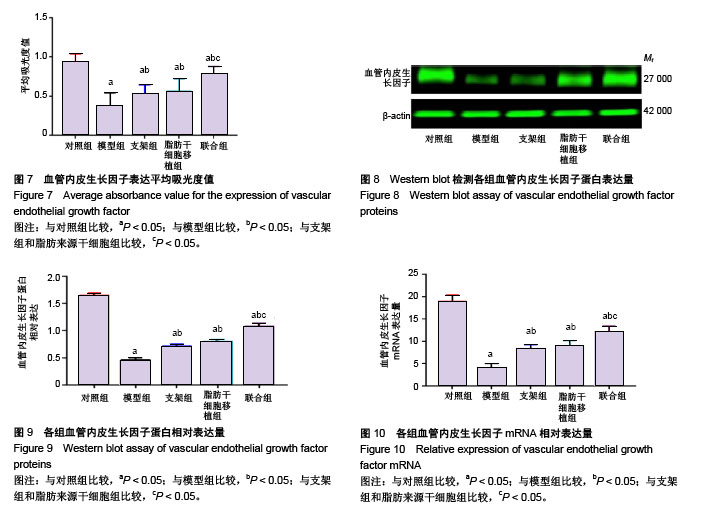| [1] Menke NB, Ward KR, Witten TM, et al. Impaired wound healing. Clin Dermatol. 2007;25(1):19-25. [2] 赵珮娟,程辰,谢芸等.脂肪来源干细胞相关生长因子及其作用的研究进展[J].组织工程与重建外科.2013,5:285-288.[3] 孙哲.脂肪干细胞与碱性成纤维细胞生长因子在颗粒脂肪移植中应用的研究进展[J].医学综述.2012;18(15):2401-2403.[4] Yoshimura K, Asano Y, Aoi N, et al. Progenitor-enriched adipose tissue transplantation as rescue for breast implant complications. Breast J. 2010;16(2):169-175. [5] 张元政,邢新,杨超.脂肪来源干细胞修复创面的研究进展[J].中国美容整形外科杂志,2014,25(12):742-744.[6] Choi JH, Gimble JM, Lee K, et al. Adipose tissue engineering for soft tissue regeneration. Tissue Eng Part B Rev. 2010;16(4):413. [7] 莫小强,金萌,唐乾利,等.皮肤再生医疗技术对大鼠慢性难愈合创面组织匀浆中TNF-α和 IL-6水平的影响[J].山东医药, 2016,56(42):24-27.[8] 赵京禹,付小兵,雷永红,等.大鼠小面积全层皮肤缺损创面模型的制备[J].感染、炎症、修复,2008,9(1):64.[9] 万滢聪,朱以香,韦义红,等.溃愈速联合明胶海绵对大鼠难愈性创面愈合的作用及机理研究[J].时珍国医国药,2014,25(1):63-65.[10] 依里牙尔·依里哈木,王云海,王理,等.脂肪干细胞体外分离培养鉴定及免疫学性质[J].中国组织工程研究, 2014,18(14):2167-2172.[11] Huang SJ, Fu RH, Shyu WC, et al. Adipose-derived stem cells: isolation, characterization, and differentiation potential. Cell Transplant. 2013;22(4):701. [12] Baquerizo Nole KL, Kirsner RS. Advanced wound care therapies in non-healing lower extremity ulcers: high expectations, low evidence. Evid Based Med. 2014;19(3):91. [13] Saito T, Izumi K, Shiomi A, et al. Zoledronic acid impairs re-epithelialization through down-regulation of integrin αvβ6 and transforming growth factor beta signalling in a three-dimensional in vitro wound healing model. Int J Oral Maxillofac Surg. 2014;43(3):373-80. [14] 王凌峰,李俊亮.难愈性创面与细菌的探讨[J].中华损伤与修复杂志, 2012, 7(4):7-11.[15] Tomita M, Kabeya Y, Okisugi M, et al. Diabetic microangiopathy is an independent predictor of incident diabetic foot ulcer. J Diabetes Res. 2016;2016(7):5938540. [16] 夏鹏,童文祥,喻永敏,等.大鼠皮肤切创愈合过程中VEGF,TGF-β1蛋白的表达[J].重庆医科大学学报, 2010,35(8):1167-1171.[17] Cramer T, Schipani E, Johnson RS, et al. Expression of VEGF isoforms by epiphyseal chondrocytes during low-oxygen tension is HIF-1α dependent. Osteoarthritis Cartilage. 2004;12(6):433. [18] 景丽峰.PI3K/Akt-HIF-1信号系统在糖尿病创面愈合过程中的表达及其意义[D].广州:南方医科大学,2014.[19] Jung KH, Song SU, Yi T, et al. Human bone marrow-derived clonal mesenchymal stem cells inhibit inflammation and reduce acute pancreatitis in rats. Gastroenterology. 2011;140(3):998. [20] Rodriguez AM, Elabd C, Amri EZ, et al. The human adipose tissue is a source of multipotent stem cells. Biochimie. 2005;87(1):125-128. [21] Safford KM, Hicok KC, Safford SD, et al. Neurogenic differentiation of murine and human adipose-derived stromal cells. Biochem Biophys Res Commun. 2002;294(2):371-379. [22] Vieira NM, Brandalise V, Zucconi E, et al. Isolation, characterization, and differentiation potential of canine adipose-derived stem cells. Cell transplantation. 2010;19(3):279-289. [23] Locke M, Windsor J, Dunbar PR. Human adipose-derived stem cells: isolation, characterization and applications in surgery. ANZ J Surg. 2009;79(4):235. [24] Nie C, Yang D, Xu J, et al. Locally administered adipose-derived stem cells accelerate wound healing through differentiation and vasculogenesis. Cell Transplant. 2011;20(2):205-216. [25] 董瑶,董飞君,李幼华.脂肪干细胞调节创面炎症反应并促进创面愈合[J].医学研究杂志,2012,41(3):100-103.[26] Lee SH, Sang YJ, Jin SS, et al. Paracrine effects of adipose-derived stem cells on keratinocytes and dermal fibroblasts. Ann Dermatol. 2012;24(2):136. [27] Jung H, Kim HH, Lee DH, et al. Transforming growth factor-beta 1 in adipose derived stem cells conditioned medium is a dominant paracrine mediator determines hyaluronic acid and collagen expression profile. Cytotechnology. 2011;63(1):57-66. [28] Zanetti AS, Sabliov C, Gimble JM, et al. Human adipose-derived stem cells and three-dimensional scaffold constructs: a review of the biomaterials and models currently used for bone regeneration. J Biomed Mater Res B Appl Biomater. 2013;101(1):187. [29] Kim SS, Song CK, Shon SK, et al. Effects of human amniotic membrane grafts combined with marrow mesenchymal stem cells on healing of full-thickness skin defects in rabbits. Cell Tissue Res. 2009; 336(1):59-66. [30] 鞠晓军,潘锋,柏树令,等.人脱细胞羊膜复合脂肪源性干细胞修复大鼠全层皮肤缺损的实验研究[J].中国修复重建外科杂志, 2010,2:143-149.[31] 聂春磊,管强,刘国锋,等.基于脱细胞真皮基质支架的脂肪源性干细胞移植对糖尿病大鼠创面愈合的影响[J].哈尔滨医科大学学报,2017,51(1):1-7.[32] 杨超,邢新,徐达圆,等.脂肪干细胞-透明质酸复合物促进放射性复合损伤创面愈合的初步研究[J].中国修复重建外科杂志, 2011,12:1499-1503.[33] Altman AM, Yan Y, Matthias N, et al. IFATS collection: Human adipose-derived stem cells seeded on a silk fibroin-chitosan scaffold enhance wound repair in a murine soft tissue injury model. Stem Cells. 2009;27(1):250. [34] 陈柏秋,彭文要,邱加崇,等.人工真皮在治疗皮肤撕脱伤的临床应用[J].中国伤残医学,2013,21(9):20-21. |
.jpg)



.jpg)
.jpg)
.jpg)
.jpg)